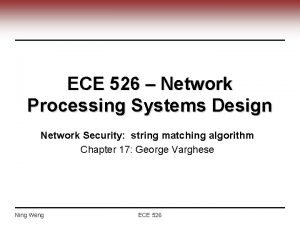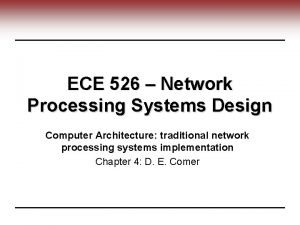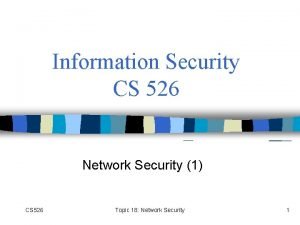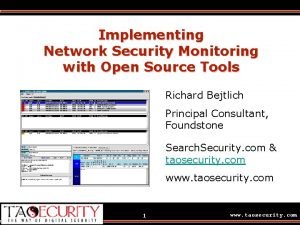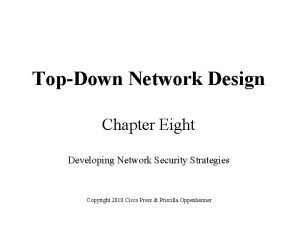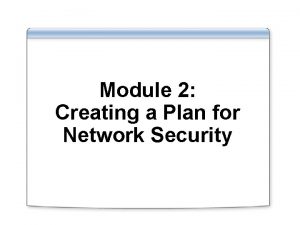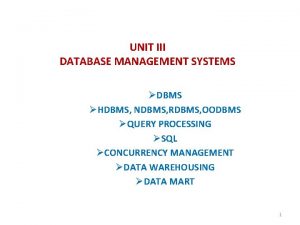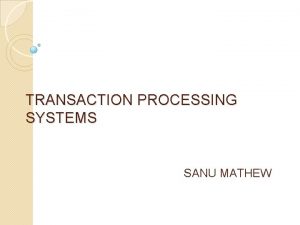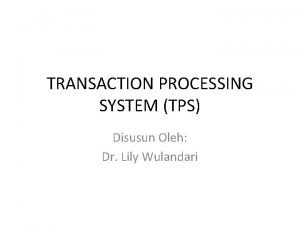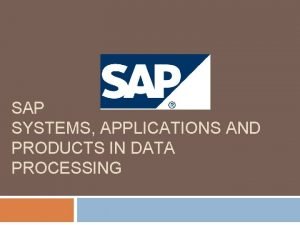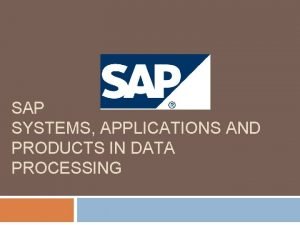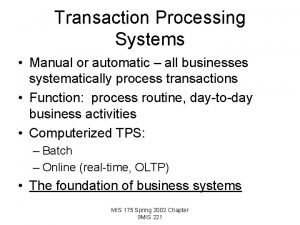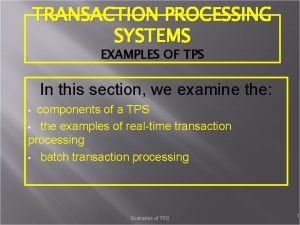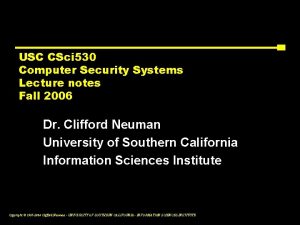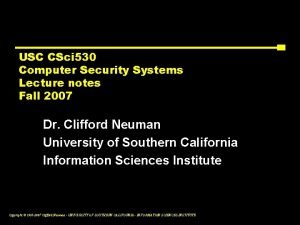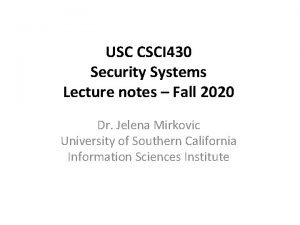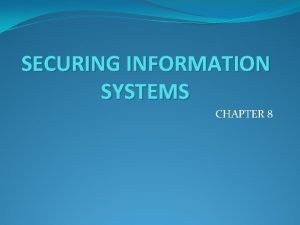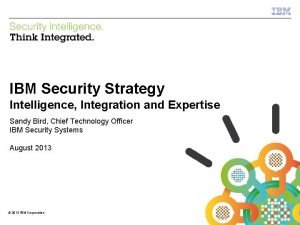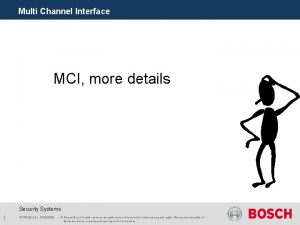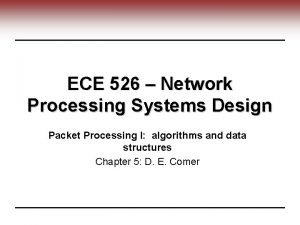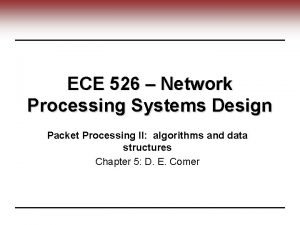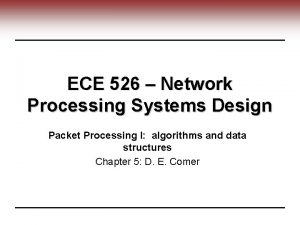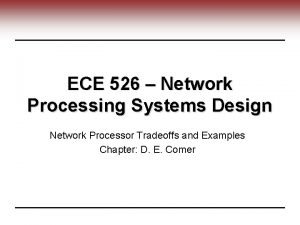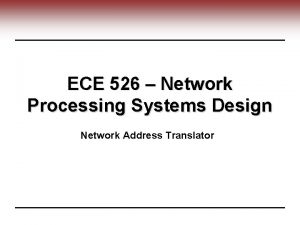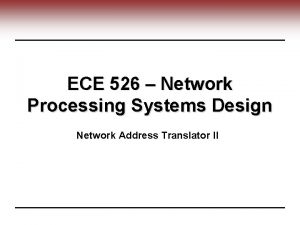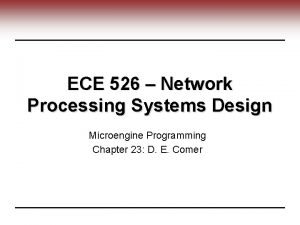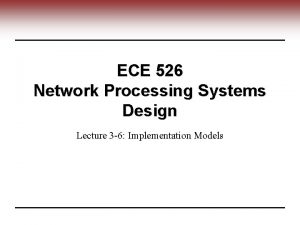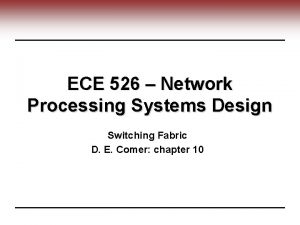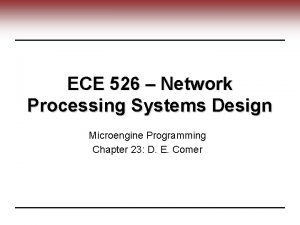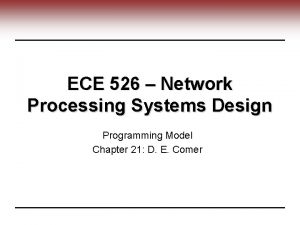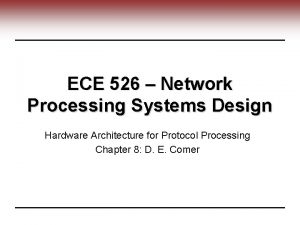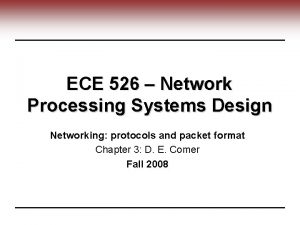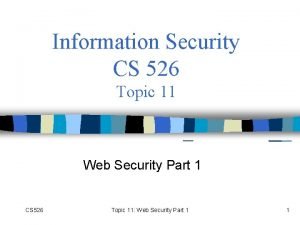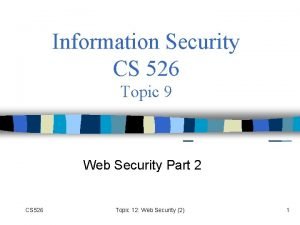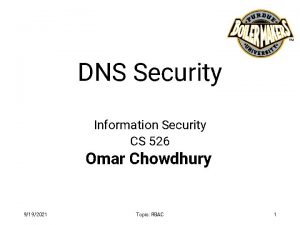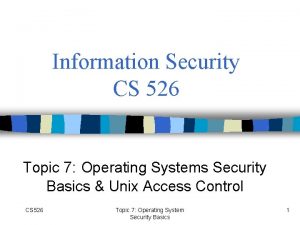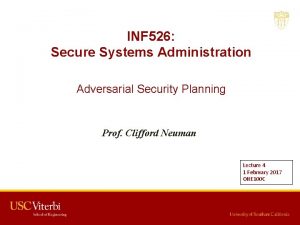ECE 526 Network Processing Systems Design Network Security


































































- Slides: 66

ECE 526 – Network Processing Systems Design Network Security 11/10 -12/2008

What is network security Confidentiality: only sender, intended receiver should “understand” message contents Authentication: sender, receiver want to confirm identity of each other Message integrity: sender, receiver want to ensure message not altered (in transit, or afterwards) without detection Access and availability: services must be accessible and available to valid users only Ning Weng ECE 526 2

Attack Types eavesdrop: intercept messages actively insert messages into connection impersonation: can fake (spoof) source address in packet (or any field in packet) hijacking: “take over” ongoing connection by removing sender or receiver, inserting himself in place denial of service: prevent service from being used by others (e. g. , by overloading resources) 3

Security in Exiting Internet “At least we understand cryptography now…” Ning Weng ECE 526 4

Cryptography for Confidentiality Alice’s K encryption A key plaintext encryption algorithm Bob’s K decryption B key ciphertext decryption plaintext algorithm symmetric key crypto: sender, receiver keys identical Pros and cons: public-key crypto: encryption key public, decryption key secret (private) Pros and cons: 5

Cryptography for Message Integrity large message m H: hash function Bob’s private key + - KB encrypted msg digest H(m) digital signature (encrypt) encrypted msg digest KB(H(m)) large message m H: hash function KB(H(m)) Bob’s public key + KB H(m) digital signature (decrypt) H(m) equal ? Alice verifies signature and integrity of digitally signed message Integrity using the hash function Signature is the encryption key, encrypt h(m) instead of messages. 6

Cryptography for Authentication number (R) used only once –in-a-lifetime Potential problem: in the middle attack “I am Alice” R Bob computes + - - K A (R) “send me your public key” + KA KA(KA (R)) = R and knows only Alice could have the private key, that encrypted R such that + K (K (R)) = R A A 7

What NP systems can Do to improve Access and availability 8

Firewalls firewall isolates organization’s internal net from larger Internet, allowing some packets to pass, blocking others. public Internet administered network firewall 9

Firewalls: Why prevent denial of service attacks: ─ SYN flooding: attacker establishes many bogus TCP connections, no resources left for “real” connections prevent illegal modification/access of internal data. ─ e. g. , attacker replaces CIA’s homepage with something else allow only authorized access to inside network (set of authenticated users/hosts) three types of firewalls: ─ stateless packet filters ─ stateful packet filters ─ application gateways 10

Credential-based Networks to improve Access and availability 11

Setup Credentials Ning Weng ECE 526 12

Credentials Data Structure • m: # of bit in the array • n: # of hash functions • r: # of hops Two steps of bloom filter 1. Programming 2. Query Ning Weng ECE 526 13

False Positive Probability • false negative is impossible ->legal packet will be forwarded • false positive is possible -> how big the chance Ning Weng ECE 526 14

Intrusion detection systems • multiple IDSs: different types of checking at different locations application gateway firewall Internet internal network IDS sensors Web server FTP server DNS server demilitarized zone 15

Intrusion detection systems • packet filtering: ─ operates on TCP/IP headers only ─ no correlation check among sessions • IDS: intrusion detection system ─ deep packet inspection: look at packet contents (e. g. , check character strings in packet against database of known virus, attack strings) ─ examine correlation among multiple packets • port scanning • network mapping • Do. S attack 16

NIDS Techniques • • Signature-based Anomaly-based Stateful detection Application-level detection 17

Signature-base NIDS Similar to the traditional anti-virus applications Example: Martin Overton, “Anti-Malware Tools: Intrusion Detection Systems”, European Institute for Computer Anti-Virus Research (EICAR), 2005 Signature found at W 32. Netsky. p binary sample Rules for Snort: 18

Signature matching • Used in intrusion prevention/detection, application classification, load balancing • Input: byte string from the payload of packet(s) ─ Hence the name “deep packet inspection” • Output: the positions at which various signatures match. • challenges ─ thousand of possible signature ─ high performance requirement ─ easy to update the new patterns 19

DFA construction • Example: P = {he, she, his, hers} • Initial State • Transition Function • State • Accepting State • h • 2 • h • 6 • s • S • h • 8 • 7 • s • 9 Ning Weng ECE 526 • S • 3 • i • S • r • s • S • 1 • e • h • 0 • i • h • r • h • 4 • S • e • 5 • S • h • S 20

DFA Searching • Matching String • h • Input stream: • h • x • h • e • r • s • h • 0 • s • S • e • 1 • S • h • i • 2 • 6 • h • S • h • s • r • 8 • 7 • s • h • S • 9 • S • 3 • h • i • 4 • S • h • r • e • 5 • Scanning input stream only once • Complexity: linear time • . Ning Weng ECE 526 21

Network Attack Patterns 22

DFA mapped to Traditional Memory • 256 entries for each state • Snort Dec. 2005 has 2733 patterns • Needs 27000 states • Memory size – 13 MB 23

SAM-FSM • Traditional – 13 MB; Ours – 16 KB 24

Overall System 25

Anomaly-based NIDS • Signature-based NIDS can’t detect zero-day attacks • Anomaly: Operations deviate from normal behavior. • What could cause anomaly? ─ ─ Malfunction of network devices Network overload Malicious attacks, like Do. S/DDo. S attacks Other network intrusions • Two main kinds of network anomalies. 1. Related to network failures and performance problems. 2. Security-related problems: (1) Resource depletion (2) Bandwidth depletion 26

Key Technical Challenges w Large data size ─ Millions of network connections are common for commercial network sites w High dimensionality ─ Hundreds of dimensions are possible w Temporal nature of the data ─ Data points close in time - highly correlated w Skewed class distribution “Mining needle in a haystack. So much hay and so little time” ─ Interesting events are very rare looking for the “needle in a haystack” w High Performance Computing (HPC) is critical for on-line analysis and scalability to very large data sets 27

Anomaly detection meets troubles • There are many schemes based on checking abrupt traffic changes. ─ E. g. apply signal processing technique to detect out traffic’s abrupt change • However, this kind of anomaly does not always mean illegitimate. ─ Abrupt change of traffic does not mean an attack has exactly happened • We call this case as: Legitimately-abrupt-change (LAC) 28

Legitimately abrupt changes • Example 1: ─ Famous information gateway websites, e. g. Yahoo. • When bombastic news is announced, it would appear. • Example 2: ─ Special information announce center, e. g. the website of national meteorological agency • When a nature disaster is said to be coming, it would occur. – Typhoon, Earthquake, Tsunami • Important outdoor holidays 29

Anomaly Detection • Already used by industry --Protocol Anomaly --Statistical/Threshold based • In Research --Data mining 30

Protocol Anomaly Detection Based on the well established RFCs Focus on the packet header Example: --All SMTP commands have a fixed maximum size. If the size exceeds the limit, it could be a buffer overflow or malicious code inserting attack --SYN flood attack: attacker sends SYN with fake source address --Teardrop attack: fragmented IP packets with overlapped offset 31

Threshold based Using training data to generate a statistical model, then select proper thresholds for network environment (traffic volume, TCP packet count, IP fragments count, etc. ) -- usually used as an complementary tool 32

Stateful IDS • No practical Solutions • Very simplementing Example: Snort uses patter matching in continuous Packets. Traditional signature rules: “pattern 1” “pattern 1 || pattern 2” The rule now can be defined as: “pattern 1. *pattern 2” 33

Application-level IDS Focus on specific services or programs (Web Server, Database, etc. ) Example --Monitoring all invocation for Microsoft RPCs --Analyze HTTP request for malicious query strings Products: --mod_security: an optional IDS component for Apache Web Server 34

Current NIDS Challenges • High false positives -- FP of 0. 1% means a normal packet will be misclassified as an alert for every 1000 normal packets, which is about one error alert per minute on a 100 M network • Zero day attack (unknown attack) --Most current products rely on signature-based detection, difficult to detect new attacks. • Poor at automatically preventing ability --Human interaction is required when attack is detected 35

IDS Today Products • • • Snort Mc. Afee Intrushield ISS Real. Secure Cisco IPS Symantec IDS 36

Snort • • • Open Source, since 1998 Used by many major network security products Signature-based (more than 3000) Simple IP header protocol anomaly detection Simple stateful pattern matching 37

Mc. Afee • Profile-based anomaly detection --Manually create profile --Create profile by self-learning through a training period • Using profile plus threshold for defending against DOS and DDOS • Inspect encrypted traffic by collecting the server side private keys 38

ISS Real. Secure • About 2000 signatures • Application-based approach --identifying any possible exploit to the published vulnerabilities of MS RPC, IIS, Apache, Lotus, etc. • Additional support for P 2 P, Instant Messengers • Virtual Prevention System --a virtual environment to examine the execution of a file in order to find any possible malicious behaviors • Support for IPv 6 --Detect possible backdoors which enable the IPv 6 of a system (usually off) 39

Cisco IPS produtcs • Protocol decoding • Threshold based property checking • Signature matching • Protocol Anomaly Detection • Checking file behaviors by intercepting all calls to the system resources 40

Symantec • Multi-steps (protocol, vulnerability, signature, DOS, traffic, evasion check) • Unique feature: evasion check e. g. request “/index. html” can be replace with “/%69 nd%65 x. html” to evade the signature matching 41

Summary of Current Products Signature General Snort Mc. Afee Intrushield ISS Real. Secure Cisco IDS Symantec IMUNE x x x Application based Anomaly Detection x Profile-based x Vulnerability-based x Statistical-based Protocol-based x x Self-learning x Application specific x Stateful IPv 6 Support x x x x Behavior Encrypted Traffic Detection x x x 42

Academia on Anomaly Detection • Columbia University --Data mining based (since 1997) • University of California at Santa Barbara --Service Specific (HTTP) --Stateful IDS • Florida Institute of Technology --Protocol Anomaly (Statistical based) • University of Minnesota --MIND (Minnesota Intrusion Detection System) 43

Columbia Univ. IDS • 1997, Applied RIPPER rule learning algorithm on UNIX system calls monitoring for malicious events detection • 1998, Applied the algorithm on off-line network traffic data (clean training data) • 2000, Applied EM and clustering algorithm for dealing with noisy dataset • 2001, Developed an complete experiment NIDS based on those algorithms. • 2004, New approach towards payload anomaly detection 44

Implementing Procedure • Wenke Lee, Sal Stolfo, and Kui Mok. , “A Data Mining Framework for Building Intrusion Detection Models”, Proceedings of the 1999 IEEE Symposium on Security and Privacy, Oakland, CA, May 1999 • Pre-Processing • Process raw packet data • Feature construction • Apply RIPPER algorithm • Create statistic features • Rule learning 45

Pre Processing • SYN flood attack 46

Feature Construction (service=http, flag=S 0, dst_host=victim), (service=http, flag=S 0, dst_host=victim) -> (service=http, flag=S 0, dst_host=victim) [0. 93, 0. 03, 2] 93% of the time, after two http connections with S 0 flag are made to host victim, within 2 seconds from the first of these two, the third similar connection is made, and this pattern occurs in 3% of the data 47

RIPPLE Rules smurf : - service=ecr_i, host_count >= 5, host_srv_count>=5 ( if the service is icmp echo request, and connections with the same destination host are at least 5, and connections with the same service are at least 5, then it is a smurf/DOS attack) satan : - host_REJ_%>=83%, host_diff_srv_% >= 87% ( for connections with the same destination host, if the rejection rate is at least 83%, and the percentage of different services is at least 87%, then it is a santa/PROBING attack) 48

Experiment Results • Applied on DARPA’ 98 Intrusion Detection Evaluation Data Set 49

Payload based Approach K. Wang, S. J. Stolfo, “Anomalous Payload-based Network Intrusion Detection”, RAID 2004 • Construct the statistical model for all bytes in the header • Use Mahananobis distance to measure the difference Problems: • Clean training data is required • False positive (unacceptable) 50

Service Specific IDS by UCSB V. Giovanni et al at University of California at Santa Barbara Since 2002 • Application level • Focuses on HTTP request • HTTP request analyzing • Constructing models for important fields in the request instead of all bytes of the payload (Columbia payload approach) 51

Sample Request GET /scripts/access. pl? user=johndoe&cred=admin Properties for Detection Request Type: e. g. GET Request Length: e. g. Length(“GET /scripts/access. pl? user=johndoe&cred=admin”) Payload Distribution 52

Request Type Assumption: If a rare used request type was found, it is very possible it will initiate malicious activity Anomaly Score: AStype=-log 2(p[type]) P[type] stands for the probability of a certain type 53

Request Length Assumption: The request length should not vary much of a certain type. Otherwise, it is probably caused by some attacks (e. g. overflow) Anomaly Score: ASlen=1. 5(1 - )/(2. 5* ) P[type] stands for the probability of a certain type 54

Characters Distribution 256 ASCII Characters e. g. “passwd” -> “ 112 97 115 119 100” Distributions: {0. 33, 0. 17, 0. 17} 2=f(Oi, Ei) (i corresponds from segment 0 to 5) Aspd= 2*(15/L) (L stands for the payload length) Segment 0 1 2 3 4 5 ASCII Value 0 1 -3 4 -6 7 -11 12 -15 16 -255 55

Final Anomaly Score AS=0. 3*AStype + 0. 3*ASlen+0. 4*ASpd 56

Later Research at UCSB Structure Inference with Markov Model 57

Other Properties Used • Token Finder if the query parameter is drawn from known candidates • Attribute Presence or absence malicious crafted request usually ignore the order of parameters • Access Frequency • Invocation order • Request time interval 58

Experiment Results • Tested at UCSB campus network and Google • False positive 0. 06% Major cons: Limited to HTTP service 59

Packet Header Anomaly Detection (PHAD) developed by Florida Institute of Technology since 2001 Basic Assumption: If an event x happened n times with r different results in the training period, the probability of a novel data is r/n 60

Implementing Step 1: Assign the novel data probability to important fields of the packet header (protocol type, flags, etc. ) Step 2: Adding all the novel data probability together as a threshold 61

MINDS (Minnesota Intrusion Detection System) Statistic outlier-based anomaly detection Compared 5 outlier-based scheme: • K-th nearest neighbor • Nearest neighbor • Mahalanobis-distance based • Local Outlier Factor (LOF) • Unsupervised SVMs 62

Comparison Result • A. Lazarevic, et al, “A Comparative Study of Anomaly Detection Schemes in Network Intrusion Detection”, Proceedings of the 3 rd SIAM Conference on Data Mining, San Francisco, 2003 63

Some Emerging Approaches • SVMs (unsupervised and supervised) • PCA + SVMs • Neural Network 64

Conclusion • Network is lacking of security • Crypto is well understood and used • NIDS ─ Signature based approaches still play the major part in practical IDS ─ Anomaly detection has only very limited success ─ New approaches are proposed everyday, but false positive and detection rate are still the major problem ─ Various mechanisms should work together for maximum success 65

Reference • Jim Kurose: Computer Networks • Tilman Wolf: Credential-based Networks Ning Weng ECE 526 66
 Ece 526
Ece 526 Ece 526
Ece 526 Ece 526
Ece 526 Privat security
Privat security Byzantine empire flocabulary
Byzantine empire flocabulary Brb sempure 60
Brb sempure 60 Byzantine empire 526 ce
Byzantine empire 526 ce Rounding jeopardy
Rounding jeopardy Salmo 526 completo
Salmo 526 completo Network security process
Network security process Osi security architecture in network security
Osi security architecture in network security Security guide to network security fundamentals
Security guide to network security fundamentals Wireless security in cryptography
Wireless security in cryptography Electronic mail security in network security
Electronic mail security in network security Security guide to network security fundamentals
Security guide to network security fundamentals Security guide to network security fundamentals
Security guide to network security fundamentals Open source network security monitoring
Open source network security monitoring Network security design and implementation
Network security design and implementation Top-down network design
Top-down network design Planning phase for network security design
Planning phase for network security design Firewall design principles in network security
Firewall design principles in network security Top.down processing
Top.down processing Gloria suarez
Gloria suarez Top-down processing vs bottom-up processing
Top-down processing vs bottom-up processing Neighborhood averaging in image processing
Neighborhood averaging in image processing Primary food processing examples
Primary food processing examples Point processing in image processing example
Point processing in image processing example Histogram processing in digital image processing
Histogram processing in digital image processing Parallel processing vs concurrent processing
Parallel processing vs concurrent processing Nonlinear image processing
Nonlinear image processing پردازش تصویر
پردازش تصویر Gonzalez
Gonzalez Top-down processing
Top-down processing Batch processing and interactive processing
Batch processing and interactive processing Ece senior design gatech
Ece senior design gatech Visa international security model
Visa international security model Cnss security model 27 cells example
Cnss security model 27 cells example Security policy and integrated security in e-commerce
Security policy and integrated security in e-commerce Software security building security in
Software security building security in Features of hdbms
Features of hdbms Transaction processing system examples
Transaction processing system examples Data processing system adalah
Data processing system adalah Sap systems applications and products
Sap systems applications and products Sap in data processing
Sap in data processing Transaction processing systems
Transaction processing systems Pros and cons of transaction processing systems
Pros and cons of transaction processing systems Tps example
Tps example Csci 530 security systems
Csci 530 security systems Csci 530 security systems
Csci 530 security systems Csci430
Csci430 Argus security system
Argus security system High security fencing trinidad
High security fencing trinidad An information systems examines a firm's overall security
An information systems examines a firm's overall security Security architecture for systems engineer sase 500 651
Security architecture for systems engineer sase 500 651 Unit 7 organisational systems security
Unit 7 organisational systems security Networked systems security
Networked systems security Horizontal integration
Horizontal integration Monroe lock
Monroe lock Trustworthy security systems
Trustworthy security systems Mci security systems
Mci security systems Systems security engineering capability maturity model
Systems security engineering capability maturity model Unit 7 organisational systems security
Unit 7 organisational systems security Decision support systems and intelligent systems
Decision support systems and intelligent systems Principles of complex systems for systems engineering
Principles of complex systems for systems engineering Embedded systems vs cyber physical systems
Embedded systems vs cyber physical systems Engineering elegant systems: theory of systems engineering
Engineering elegant systems: theory of systems engineering The designer expresses the ideas in terms related to the
The designer expresses the ideas in terms related to the
